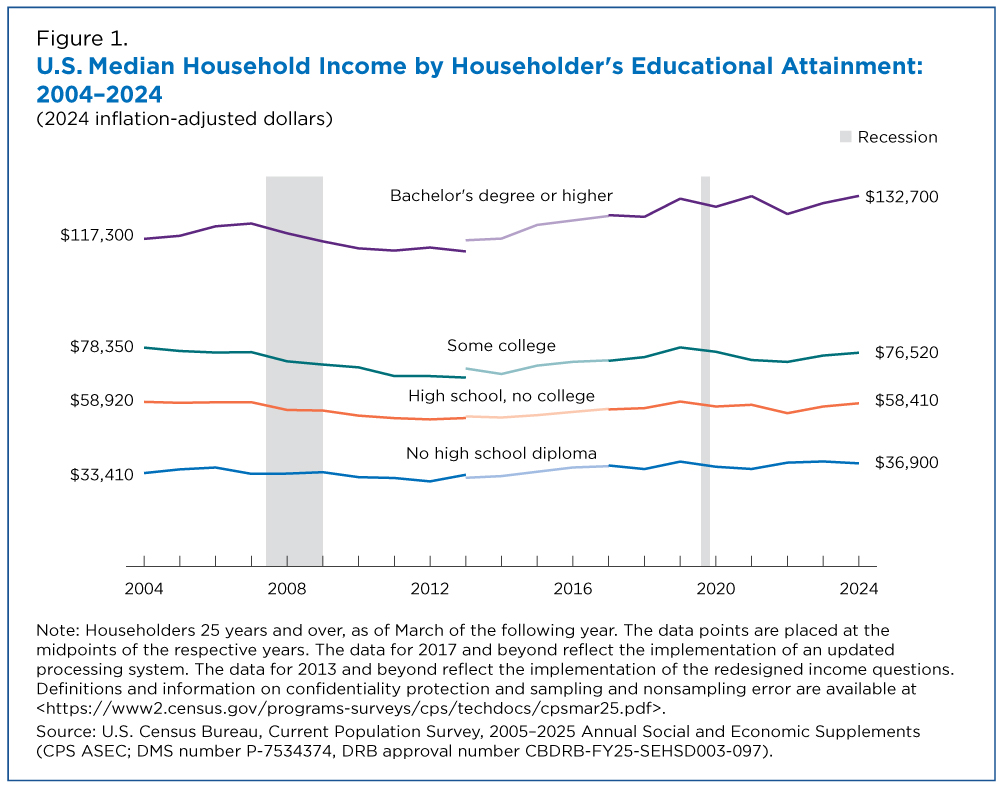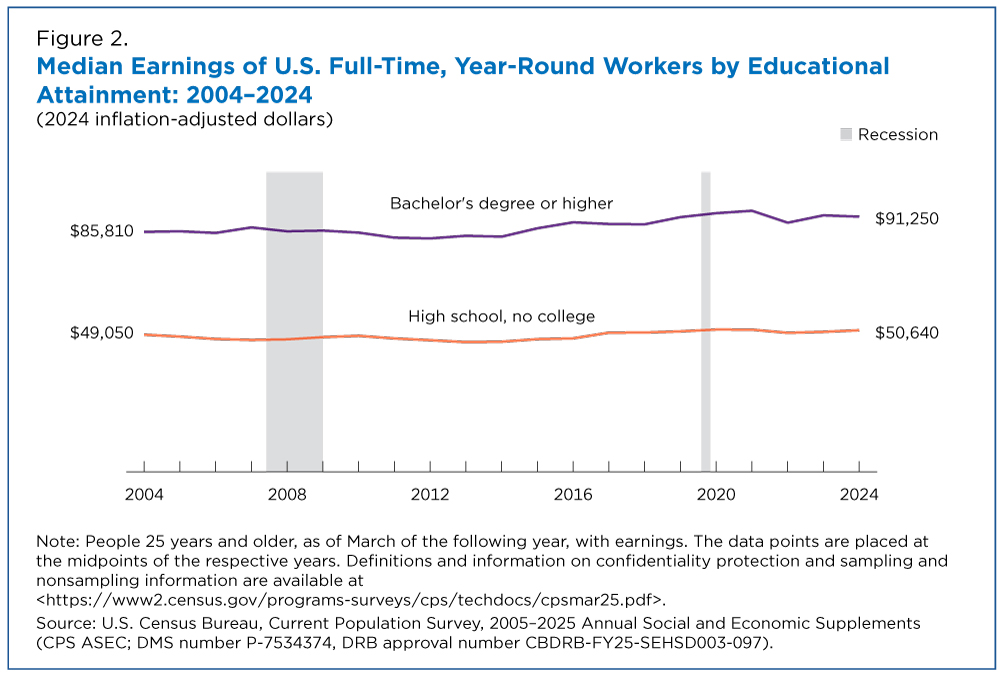Income Gap Between Householders With College Degrees and Those With High School Degrees but No College Widened Over Last Two Decades
Median household income in the United States for householders age 25 and over was $85,580 in 2024 — marking an 18% increase from 2004. However, the income gap between those with college degrees and those with high school degrees but no college widened over the last two decades.
Median household income is the midpoint where half of households make more in income, and half make less. All estimates here are presented in 2024 inflation-adjusted dollars.
Between 2004 and 2024, earnings of those with a high school degree but no college rose 3.2%, while earnings of those with a bachelor’s degree or more went up 6.3%.
The Current Population Survey Annual Social and Economic Supplement (CPS ASEC) released today measures educational attainment of householders age 25 and older and shows education has a significant impact on household income.
For example, the median income of households headed by someone with a bachelor’s degree or higher was $132,700, more than double the $58,410 median income of those with householders with a high school degree but no college in 2024, according to a new report released today.
Education’s Impact on Income Over Two Decades
Estimated median household income of householders with only a high school degree didn’t change significantly from 2004 ($58,410) to 2024 ($58,920).
There was also no significant increase in income for those with some college education between 2004 and 2024.
By contrast, households at the opposite ends of the education spectrum saw their median income rise.
The median household income of those with at least a bachelor’s degree rose by about $15,000 or 13.1%, while the median household income of those with less than a high school diploma (the smallest educational attainment group) climbed by about $3,500 or 10.4% (percent increases for the two groups did not significantly differ from each other).
Overall, the income gap between householders with a bachelor’s degree or higher and those with a high school degree but no college widened during the 20-year period.
In 2004, households headed by those with at least a bachelor’s degree had about twice as much income as those headed by someone with a high school degree but no college. By 2024, householders with a bachelor’s degree or higher had median household income 2.3 times higher than those with a high school degree.
The makeup of educational attainment groups also changed over time.
In recent decades, growth in the population with a bachelor’s degree or higher has been concentrated among racial and ethnic groups with historically low attainment. This growth has also disproportionately come from increasing educational attainment among women.
Earnings and Education
Median household income accounts for all pretax money income streams (earnings and other income, like Social Security, interest or dividends) for all members of a household. To show the relationship between education and employment outcomes, we also looked at individual earnings of those working full-time (35 hours or more a week), year-round (50 weeks or more).
In 2004, the median earnings of full-time, year-round workers age 25 and over with a high school degree was $49,050, compared to $85,810 for those with a bachelor’s degree or higher.
Between 2004 and 2024, earnings of those with a high school degree but no college rose 3.2%, while earnings of those with a bachelor’s degree or more went up 6.3%.
By 2024, due to differences in earnings growth by education, median earnings of adults age 25 and older with a bachelor’s degree or higher were 1.8 times those with a high school degree but no college, up from about 1.7 times in 2004.
Household Income Versus Individual Earnings
During the 20-year period, households headed by someone with a bachelor’s degree or higher saw greater gains in median household income than those with a high school degree but no college. The same holds true of the earnings of those who worked full-time, year-round.
However, the gaps between those with a bachelor’s degree or higher and those with a high school degree but no college were larger for household income than for individual earnings.
What might account for these differences?
First, household income includes many sources of income not captured by earnings, such as Social Security, interest and dividends.
In addition, a household can include members besides the householder who contribute to household income. This is especially significant among those with a bachelor’s degree, who are more likely to be married and to live with others with high levels of education, which can further boost household income.
Understanding the Relationship Between Individual Earnings and Household Income provides more information on these two measures.
The technical documentation includes information on confidentiality protection, methodology, and sampling and nonsampling error.
Published measures of sampling uncertainty for 2004 estimates (not adjusted for inflation) can be found here. All inflation adjustments use the C-CPI-U. All comparative statements have undergone statistical testing and are statistically significant at the 90% confidence level unless otherwise noted.
Related Statistics
Subscribe
Our email newsletter is sent out on the day we publish a story. Get an alert directly in your inbox to read, share and blog about our newest stories.
Contact our Public Information Office for media inquiries or interviews.
-
Income and PovertyNo Significant Change in Estimated U.S. Median Household IncomeSeptember 09, 2025Compared to pre-pandemic estimates from 2019, only Hispanic households experienced a significant increase in median household income in 2024.
-
Health InsuranceHealth Insurance Coverage Varied Significantly by OccupationSeptember 09, 2025In 2024, farming, fishing and forestry occupations had among the highest uninsured rates among workers ages 19 to 64.
-
Income and PovertyU.S. Tax System Reduces Income Inequality But Gaps RemainSeptember 09, 2025Household incomes were more equal after accounting for taxes and credits but both pretax and post-tax income inequality rose between 2009 and 2024.
-
EmploymentThe Stories Behind Census Numbers in 2025December 22, 2025A year-end review of America Counts stories on everything from families and housing to business and income.
-
Families and Living ArrangementsMore First-Time Moms Live With an Unmarried PartnerDecember 16, 2025About a quarter of all first-time mothers were cohabiting at the time of childbirth in the early 2020s. College-educated moms were more likely to be married.
-
Business and EconomyState Governments Parlay Sports Betting Into Tax WindfallDecember 10, 2025Total state-level sports betting tax revenues has increased 382% since the third quarter of 2021, when data collection began.
-
EmploymentU.S. Workforce is Aging, Especially in Some FirmsDecember 02, 2025Firms in sectors like utilities and manufacturing and states like Maine are more likely to have a high share of workers over age 55.






